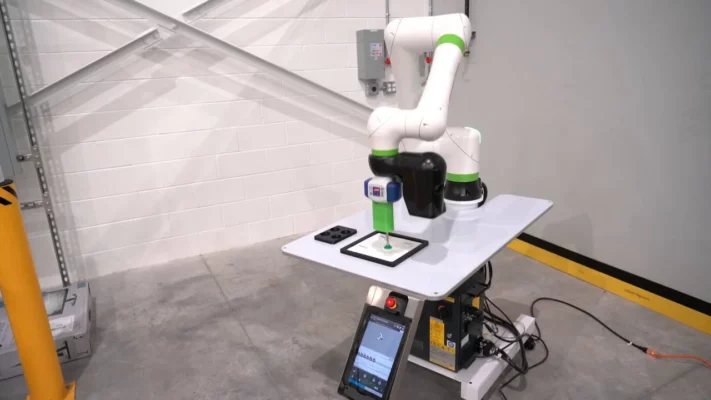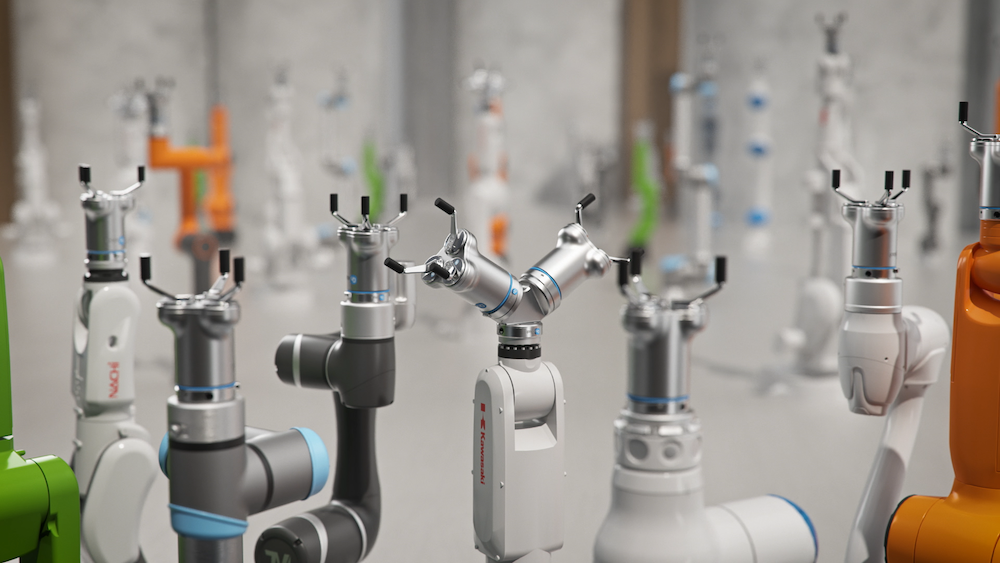Cobots are built to work right beside you, taking on the repetitive, tiring, or even risky jobs on your production floor. But what really makes them valuable isn’t just the arm itself. It’s the tool at the end of it. End of arm tools (EOATs) are what give cobots their purpose. They let your cobot grip, weld, polish, or even inspect. With the right EOAT, your cobot becomes more than a machine. It becomes a problem-solver.
In this article, you’ll learn what EOATs can do, how they work, and how to choose the right one for your application.
What are Cobots?
Cobots, or collaborative robots, are designed to work safely right next to you. Unlike traditional robots that need cages or barriers, cobots are built with safety features like force sensors and speed limits. This means they can share your workspace without putting anyone at risk.
How Are Cobots Different from Traditional Robots?
Traditional industrial robots are fast and powerful but need to be kept separate from humans. Cobots are slower, smarter, and easier to program. They’re made for flexibility, not just brute strength.
You can deploy them quickly, adjust them easily, and use them across different tasks.
This video shows how Xiamen Runner uses 64 UR cobots to improve flexibility and efficiency across 10 different manufacturing applications.
What Are End of Arm Tools (EOATs)?
End of arm tools, or EOATs, are the hands of your cobot. Just like your hands let you grip, move, and manipulate objects, EOATs give your cobot the ability to interact with its environment. Without one, a cobot can’t do much.
Why Do EOATs Matter?
EOATs turn a basic cobot into a task-specific worker. Whether you need to lift, weld, polish, screw, or inspect, the tool at the end of the arm makes it possible. It’s the EOAT that defines what your cobot can actually do on your production line.
A Wide Range of Tools:
You can choose from many types of EOATs depending on your job. There are grippers for picking parts, suction cups for handling fragile items, and even welding torches or polishing pads. Each tool brings a new capability. In the next sections, we’ll break down the main EOAT types and where they fit best.
Why EOATs Matter?
A cobot without an end of arm tool is just a moving arm. It can’t grip, lift, weld, or do anything useful. That’s why EOATs are so important. They give your cobot a job to do.
The Right Tool Unlocks Real Work:
With the right EOAT, your cobot becomes a reliable worker on your line. It can pick and place parts, load machines, screw in fasteners, weld components, or polish surfaces. One tool can turn your cobot into a specialist. Add a tool changer, and it can take on multiple tasks without stopping.
Get More from Your Investment:
EOATs are how you get the most value from your cobot. They help you automate more jobs, save time, and reduce strain on your team. The right tool doesn’t just improve one task. It lifts the performance of your entire operation. That’s why choosing the right EOAT is just as important as choosing the cobot itself.

Types of End of Arm Tooling:
Grippers:
Grippers are the most common EOATs you’ll find on cobots. They act like robotic fingers that can grab, hold, and move items around. Depending on what you’re working with, you can choose from several types: mechanical grippers are great for solid objects, while vacuum and pneumatic grippers handle delicate or irregular items smoothly. Each type has its own superpower, whether it’s gripping strength, precision, or adaptability to different shapes and sizes.
Suction Cups:
Suction cups are perfect for when you need a gentle touch. They work wonders on smooth, non-porous surfaces, making them ideal for handling glass, metal sheets, or any item where gripping might cause damage. Suction cups use vacuum technology to stick to objects, lifting them without leaving a mark. This is your go-to EOAT for tasks that require a soft grip and precision placement.
Tool Changers:
Tool changers allow your cobot to switch between different EOATs automatically, making it a jack-of-all-trades. Imagine your cobot handling assembly with a gripper, then swapping to a screwdriver to finish the job—all without manual intervention. Tool changers are the secret behind making your cobot versatile and multi-functional, ready to tackle a variety of tasks without skipping a beat.
Specialized Tools:
Sometimes, your cobot needs to do more specialized work. That’s where custom EOATs come in: welding torches, painting guns, and even inspection cameras. These tools are tailored for specific tasks, turning your cobot into a master craftsman. Whether it’s creating a perfect weld, applying a flawless coat of paint, or conducting detailed inspections, specialized tools ensure your cobot can handle tasks with expertise and precision.
By understanding the different types of EOATs available, you can outfit your cobot for virtually any task on your production line, maximizing efficiency and productivity.
Choosing the Right EOAT for Your Cobot:
Figure Out the Job:
First up, what do you need your cobot to do? Whether it’s lifting heavy items or putting together small parts, the job decides the tool. Identifying this helps you zero in on the right EOAT.
Look at What You’re Handling:
Consider the items your cobot will work with. Are they big, small, smooth, or oddly shaped? For flat items, a suction tool works great. For everything else, you might need a gripper that can adjust.
Match Tool to Cobot:
Ensure the EOAT fits your cobot. It’s like picking the right attachment for your vacuum cleaner; not every tool fits every model. Stick to the recommended list from your cobot’s maker to avoid any mix-ups.
Think About Your Workspace:
Your workspace matters. If it’s hot or wet, your EOAT needs to handle that without trouble. Pick a tool that can keep up with your environment.
Safety is Key:
Safety can’t take a back seat. Choose tools that keep your team safe. The right EOAT should work seamlessly with your cobot’s safety features, ensuring everyone can work together without worries.
Plan for Tomorrow:
Lastly, think about the future. Will this tool grow with you? Opting for an EOAT that’s flexible for different jobs means you’re set for longer, getting more bang for your buck.
By breaking it down step by step, you’ll find the perfect EOAT that not only tackles your tasks today but is also ready for whatever comes next. This way, your cobot becomes an indispensable part of your team, ready to take on challenges with you.
6 Types of Applications:
1. Pick & Place:
End-of-Arm Tools (EOAT) allow cobots to pick up and put down various parts at the same time. For example, magnetic EOAT can pick up and put down objects made of steel and iron but won’t affect non-ferrous objects.
2. Welding:
More and more companies are using welding tools for their spot-welding and arc welding tasks. It helps them make strong welds faster and keeps their workers safe. Cobots can do these jobs with little supervision, making the work quicker and safer.
3. Loading & Unloading Objects:
A company in Denmark that makes gears used a cobot and a collaborative gripper to move things in and out of its machines. They later switched to a double-grip gripper to make things even faster.
4. Material Removal:
One type of End-of-Arm-Tool (EOAT) is used to make holes and smooth materials. It’s often used in car factories.
5. Handling Delicate Objects:
Some EOATs use suction to pick up delicate items. You can adjust how strong they grip by changing the air pressure. They’re gentle and good for handling things like food.
6. Polishing:
A glass company in France used a cobot with a sensor and gripper to improve glass polishing. This change made work easier, increased production, and made employees happier because they didn’t have to do the same repetitive tasks.
Conclusion:
Let’s sum it up: the real power of your cobots comes alive with the right end of arm tools (EOATs). These tools are not just accessories; they’re essential for making your cobots work hard and smart. From handling tiny components to moving big items, the right tool can drastically change what your cobots can do. Choosing the right EOAT is about matching the tool to the task, ensuring your cobots can take on any job you throw at them. It’s this choice that transforms your production line, making every task smoother and safer.






